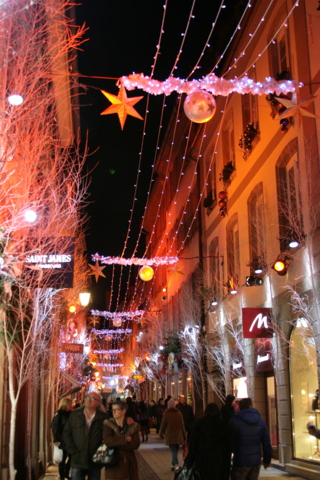This Christmas, Bob and I celebrated our first real Christmas in 38 years.

Christmas Tree in Strasbourg, France
Since we downsized our store this summer to a smaller space, we shed much responsibility and stress. Now our life is concentrated exclusively on our tea, and we have something that we are not used to – some free time, and easier life-management. While we are far from retired, we have renewed energy and feel young and almost carefree again. So in a decision based on sheer fun and self-indulgence, we decided to do something that we have always longed to do – visit Christmas Market in the Alsace region of France and parts of Germany. So we made a plan, booked flights, hotels and trains for late November and let the anticipation build. We were not disappointed.

Colmar, France
Christmas Markets begin their festivities in the days right before Advent and continue up until Christmas Day. The markets continue a tradition of selling and trading and gathering people together for joyful celebration that began 400-500 years ago in medieval cities and towns across Europe. Today, this festive spirit continues in most cities and many small towns, in the main medieval market square or in the streets surrounding a cathedral or prominent church in the heart of old town. According to our friend Peter, who lives in Stuttgart, Germany, each village with more than 4,000 inhabitants has its own Christmas Market – or Weihnachtsmarkt – as they are known in Germany. Regional differences in the crafts and the foods sold bring different a flavor to each market, so it is best to visit several markets, both city and village, to experience the local specialties.

A vendor stall in front of Strasbourg Cathedral

Christmas Market, Nurnberg, Germany
But no matter if the market is large or small, the air is scented with the sweet perfume of spices, honey, carmel, gingerbread, and hot spiced wine, and the savory aroma of sausages grilling over a wood fire. For us, after years of selling European holiday goodies in our store – Pan d’Epice and Fruit Breads from France; Marzipan, Lebkuchen, and Stollen from Germany – this trip allowed us to taste these goodies in their historical places, and to appreciate many variations of these celebrated treats.

Candies and confections in a shop window
-
-

Two varieties of Lebkuchen
-
While Christmas Market reflects the tastes of today, it embraces the traditional past and speaks to people of all ages from many countries. We heard many languages being spoken as we wandered in these lovely towns and cities, and we were astonished at the crowds – Christmas Market is very much alive and well. Merry-makers filled the streets day and night, but the best atmosphere was in the evening when the sun went down and the lights came on. Everything from vendor stalls to timbered houses are illuminated and wrapped in a warm cozy glow. Can you see the tidal-wave of people in this photograph?

Saturday afternoon – just arriving at the Nurnberg Christmas Market!
It was delightful to see people of all ages laughing, hoisting a glass together and singing along with the street choirs and having a joyful time. Shopping temptations were many and I saw a majority of visitors carrying large tote bags filled with goodies and purchases. Grandparents found plenty of treats, edible and not, for their grandchildren. It was easy to fall in love with adorable wooden toys, carefully sewn stuffed animals, old-world inspired tree ornaments, elegant glass decorations, hand-crafted wool ornaments, stables and manger figures, and other lovely items.

Glass Temptations

Lebkuchen Santa cookies
We shopped at vendor stalls and selected small, hand-crafted tree trimmings and decorations made of pewter, wood-shavings and lace; indulged in many kinds of local sausages; drank local wine and beer, and of course, also enjoyed many glasses of the holiday spiced wine known as Vin Chaud in France and Glühwein Germany.

A very popular Christmas Market stall
We wandered in and out of charming old book stores, lusted over and purchased a few reproduction gingerbread cookie molds, visited nearly every church and cathedral to be found, and took in as much feeling and atmosphere of the old city streets as we could.
In both France and Germany, many food vendors work in their stalls – roasting chestnuts, caramelizing almonds, baking Lebkuchen gingerbread cookies, fruitbreads, etc. We were enthralled watching them work and the aromas of their foods was enticing. These displays of cakes and confections was very appealing, and shoppers were quick to snap up the best looking offerings.

Rich, honeyed fruit breads
In Germany, we watched a glass artist put the finishing touches on a richly colored piece of stained glass that depicted a drummer clad in medieval tunic and stockings keeping time on his drum. Around the corner we joined a crowd of onlookers who were mesmerized watching a baker who was giving the final decorative touches to a sheet pan of spicy Lebkuchen cookies.

Decorating a tray of ready-to-bake Lebkuchen
-

Old Lebkuchen-vendor poster in a shop window
In Alsace, city streets leading to the old square are festooned with lights and decorations, and shopkeepers add to the magical atmosphere by decorating buildings and storefronts with elaborate decorations and themes.

Pedestrian street Strasbourg, France

Above the awning of a specialty food shop in Strasbourg, France

Elegant Christmas-inspired storefront decorations
In Nurnberg, we awoke on our last full day to an overnight snowfall. It continued to snow throughout the day, adding to the fairy-tale feeling of this place. We feel truly blessed to have been able to experience a little taste of European Christmas and look forward to more years of such adventures.

My new friend!
